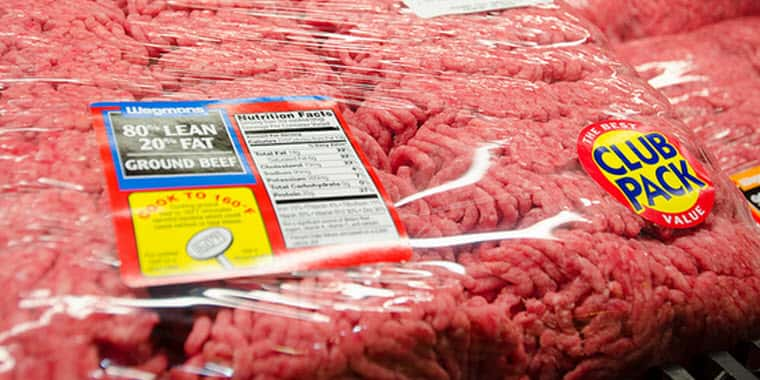WASHINGTON, D.C. – South Dakota is among those states where samples of ground beef at retail stores are being taken as the U.S. Department of Agriculture (USDA) and the livestock industry continue to respond to an outbreak of bovine influenza A (H5N1) in dairy cows.
Milk samples continue to be taken at retail grocery stores across the country.
Federal officials are seeking to verify the safety of milk and meat after confirming the H5N1 virus in 34 dairy cattle herds in nine states since late March. So far, officials with the U.S. Centers for Disease Control and Prevention (CDC) have not seen signs that the virus is changing to be more transmissible to people. Two dairy farmworkers have been infected with bird flu since the outbreak began.
Scientists say there’s no evidence to suggest people can get bird flu by consuming food that’s been pasteurized or properly cooked.
Scientist believe outbreaks are more widespread in cows than officially reported based on findings of H5N1 particles in about 20% of milk samples. The U.S. Food and Drug Administrations (FDA) has said that preliminary results of PCR tests showed pasteurization killed the virus in milk.
USDA will analyze retail ground beef samples in grocery stores with PCR tests that indicated “whether any viral particles are present.” The retail locations in the affected states have not yet been publicly identified.
Two studies will test if particles of the bovine influenza A virus, also called Type A H5N1, is found in beef for sale in the states where dairy cows have tested positive or in the muscles of dairy cows sent to slaughter. A third will test how cooking meat at different temperatures affects the virus using a bird flu surrogate.
The concern over ground beef contamination comes from dairy cattle that are processed for primarily ground beef. Already, at least one foreign country is banning fresh and frozen beef imports from the U.S. and the nine states where infections in dairy cattle have been reported. Since the initial incidents in Texas and Kansas, USDA has confirmed other HPAI infections in dairy cattle in Michigan, New Mexico, Idaho, Ohio, North Carolina, South Dakota, and Colorado.
Find Related Stories From The First Reports Of The Outbreak To Current Developments 〉
Read More Through The South Dakota Department Of Health 〉
Other states, like Nebraska, that took immediate action to restrict the movement of dairy cattle after the first notification from USDA in the third week of March, have reported no outbreaks of the virus.
Wild birds — and especially waterfowl — which are natural carriers of HPAI, are believed to be the original source of infections in cattle, according to USDA. However, the latest information indicates that the virus spreads from cow to cow.
“How the virus is spreading is not yet well understood, but there’s clear evidence of cow-to-cow transfer,” said Haley Springer, who associate clinical professor at Penn State’s Department of Veterinary and Biomedical Sciences. “I don’t think we can rule out bird introductions, but I think that’s going to be less likely than cow-to-cow transmission.”
This point was confirmed by the FDA, which announced that, although HPAI virus fragments have been found in pasteurized milk, these findings “do not represent actual virus that may be a risk to consumers.” The agency added that “to date, we have seen nothing that would change our assessment that the commercial milk supply is safe.
In news reported last week, at a recent meeting, scientists from USDA said the virus is not presenting like a respiratory illness in dairy cattle – meaning the animals don’t appear to be shedding large amounts of virus from their nose or mouths.
Instead, federal health officials investigating the outbreak suspect some form of “mechanical transmission” is responsible for spreading the virus within the herd. This may be happening during the process of milking the cows, a theory supported by the fact that high concentrations of virus are being found in the milk.
There is still no report of the pathogenic virus in beef cattle, and the ag department remains confident that the meat supply is safe.
They recommend consumers properly handle raw meats and cook to a safe internal temperature.
Also this month, USDA started requiring milk-producing dairy cows to test negative for HPAI before being transported. That followed the discovery of bird flu in dairy cattle in Texas and Kansas.
While striving to tamp down the spread of the virus, government agencies emphasized the overall safety of the food supply, noting that risks are higher for people exposed to infected animals than those who consume animal-based products. The USDA affirmed that fully cooking beef and pasteurizing milk neutralizes the virus in finished products.
“It is important to remember that thus far, we have not found changes to the virus that would make it more transmissible to humans and between people. While cases among humans in direct contact with infected animals are possible, our partners at the U.S. Centers for Disease Control and Prevention (CDC) believe that the current risk to the public remains low,” USDA declared in an April 27 statement.
In a recent news release, the Washington, D.C.-based Meat Institute reiterated that properly prepared beef remains safe to eat. “USDA and CDC are working overtime to understand the spread of the virus and to determine its effects on the health of people and animals,” remarked Julie Anna Potts, the group’s president and CEO. “We encourage USDA and CDC to conduct additional testing and monitoring to continue to ensure properly prepared beef remains safe to eat.”
She continued, “We are also calling on USDA and CDC to issue additional, specific guidance for beef processing facilities to ensure USDA inspectors and meat company workers are protected from infection.”
The CDC, for its part, posted on its site, “This is a rapidly changing situation and CDC is committed to providing frequent and timely updates.”











